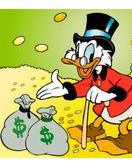(Paris; April 16, 1755-Louveciennes; March 30, 1842) was the most famous French painter of the 18th century and one of the most sought-after portrait painters of her time. Her paintings are present in a hundred museums in 20 countries.1 Her work includes 900 paintings, including 700 portraits-many self-portraits, 30 portraits of her friend Marie Antoinette and 67 portraits made during the six years of exile in Russia. . During her travels she became a member of the Academies of Florence, Rome, Bologna, St. Petersburg and Berlin. She left her memoirs written about her life.
She was born in 1755, in Paris, into a humble family, despite the reputation of her father Louis, a pastel portrait painter, which gave the family access to artistic bourgeois society. Her little brother, Étienne, three years younger than her, also showed talent as a writer.3 From her father, Louis Vigée, she received her first lessons, although she benefited more from the advice of Gabriel François Doyen, Jean-Baptiste Greuze, Claude Joseph Vernet and other masters of the time.
From the ages of 6 to 11 she lived in a boarding school and did not stop painting.


At age 12 she lost her father and first teacher, in a botched medical operation. During her adolescence she already painted portraits professionally. She began painting her own family: her mother, her brother Etienne and her stepfather, Jacques-François Le Sèvre.4 Her mother, Jeanne Massin, due to economic circumstances, remarried a man with whom the painter had no relationship. good relationship. Encouraged by her mother to continue painting, at the age of 15 Louise had her own studio.3
When her studio was seized for painting without a license, she sought affiliation with the Académie de Saint Luc, which unknowingly exhibited her paintings in her Salon. On October 25, 1774 she entered the Royal Academy of Painting and Sculpture.
Career of Marie-Louise-Élisabeth Vigée-Lebrun
Around 1774 she met Jean-Baptiste Pierre Lebrun, a painter and art dealer, a neighbor of hers, whom she married in 1776 on the recommendation of her mother, she explains in her memoirs, and to leave the house where her stepfather lived. , who she explains, had a worse and worse character after leaving her activities.2 Her husband, she also says in her writings, turned out to be a womanizer, addicted to gambling and prostitutes, on which he spent the money she earned. . But her own professional experience and collection of old masters and prints helped Louise broaden her artistic horizons and perfect her painting technique.

She painted portraits of many members of the French nobility and as her career progressed, at the age of 23, she was invited to Versailles to paint Queen Marie Antoinette.3 The first painting was painted in 1779.2 The queen was So pleased with Vigée-Lebrun's work that she was commissioned to paint more portraits of her, as well as of princes and numerous nobles.
In the early 1780s Le Brun took his wife on a trip to the Netherlands, allowing her to delve deeper into the Flemish masters and their understanding of Dutch art, especially Rubens' use of color and enamels, which It was to have a permanent influence on his art.3 There he painted portraits of some nobles and the Prince of Nassau.
On May 31, 1783 she was accepted as a member of the Royal Academy of Painting and Sculpture as a painter of historical allegories. Adélaïde Labille-Guiard, her main rival, 3 she was accepted on the same day. The men in charge opposed her admission, arguing that her husband was an art dealer, but an order from the king fixed her decision once Marie Antoinette pressured her husband in favor of the painter. The admission of two women on the same day prompted comparisons between them rather than comparisons between female and male members.
After the arrest of the royal family during the French Revolution in October 1789, Vigée Lebrun, identified as a monarchist, fled France with her 9-year-old daughter Brunette, beginning twelve years of exile, traveling first to Italy and then to Austria and Russia.3 His experience in dealing with aristocratic clients came in handy. In Rome her paintings were critically acclaimed and she was received at the Academia di San Luca. In Russia she painted numerous members of Catherine the Great's family. During her stay Vigée Lebrun was appointed a member of the Saint Petersburg Academy of Fine Arts.
In 1793 her husband was forced by the authorities of the revolution to divorce her and she assumed the support of herself and her daughter with her own work.
She eventually returned to France during the reign of Emperor Napoleon I. In demand by Europe's elite, she traveled to England in the early 19th century and painted portraits of several British notables including Lord Byron. In 1807 she traveled to Switzerland and was made an honorary member of the Societé pour l'Avancement des Beaux-Arts of Geneva.
At the urging of a friend of hers, Countess Dolgoruki, Vigée Lebrun published her memoirs in 1835 and 1837, in which she shows an interesting perspective on the training of artists at the end of the era dominated by the royal academies.
Still very active in her 50s, she bought a house in Louveciennes, Île-de-France. She lived in it until the Prussian army took it during the war of 1814. She lived in Paris until her death on March 30, 1842. She never remarried. Her body was taken back to Louveciennes where she was buried in a cemetery near her former home.
On her tombstone the epitaph reads "Ici, enfin, je repose..." ("Here, at last, I rest...").
Vigée Lebrun is considered the most important female artist of the 18th century. She left behind 660 portraits and 200 landscapes.
Marie-Louise-Élisabeth Vigée-Lebrun

